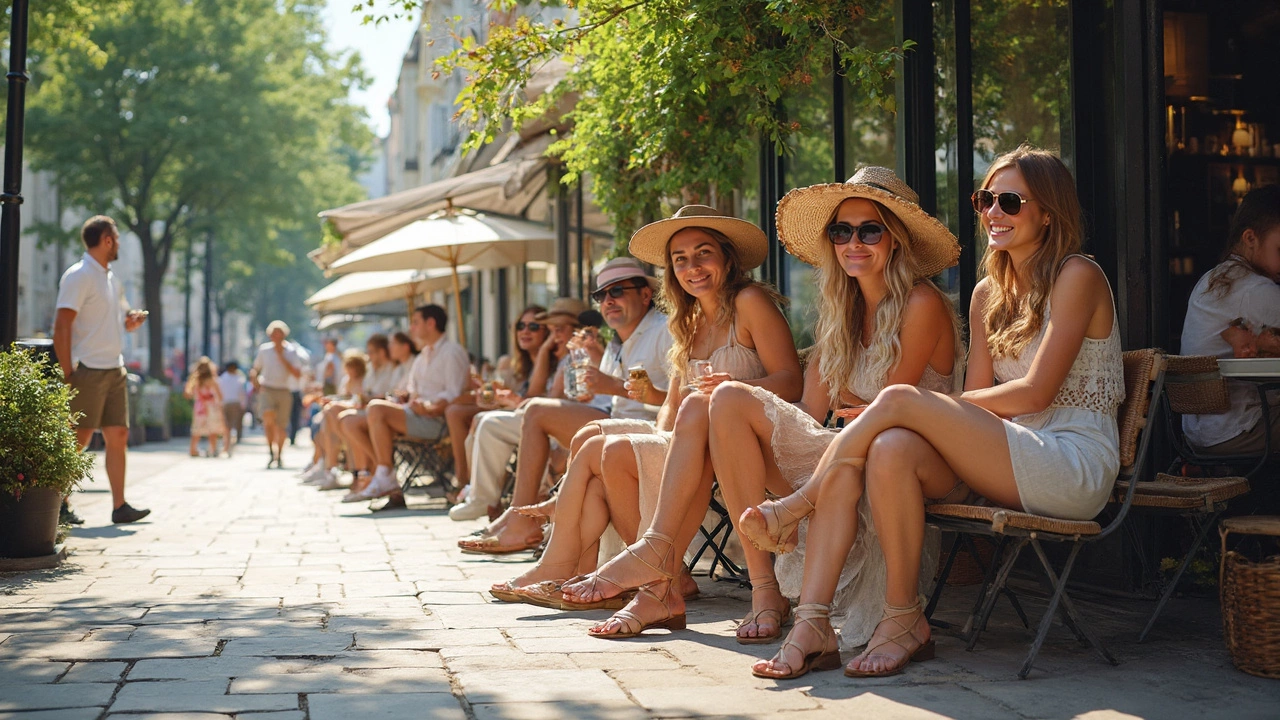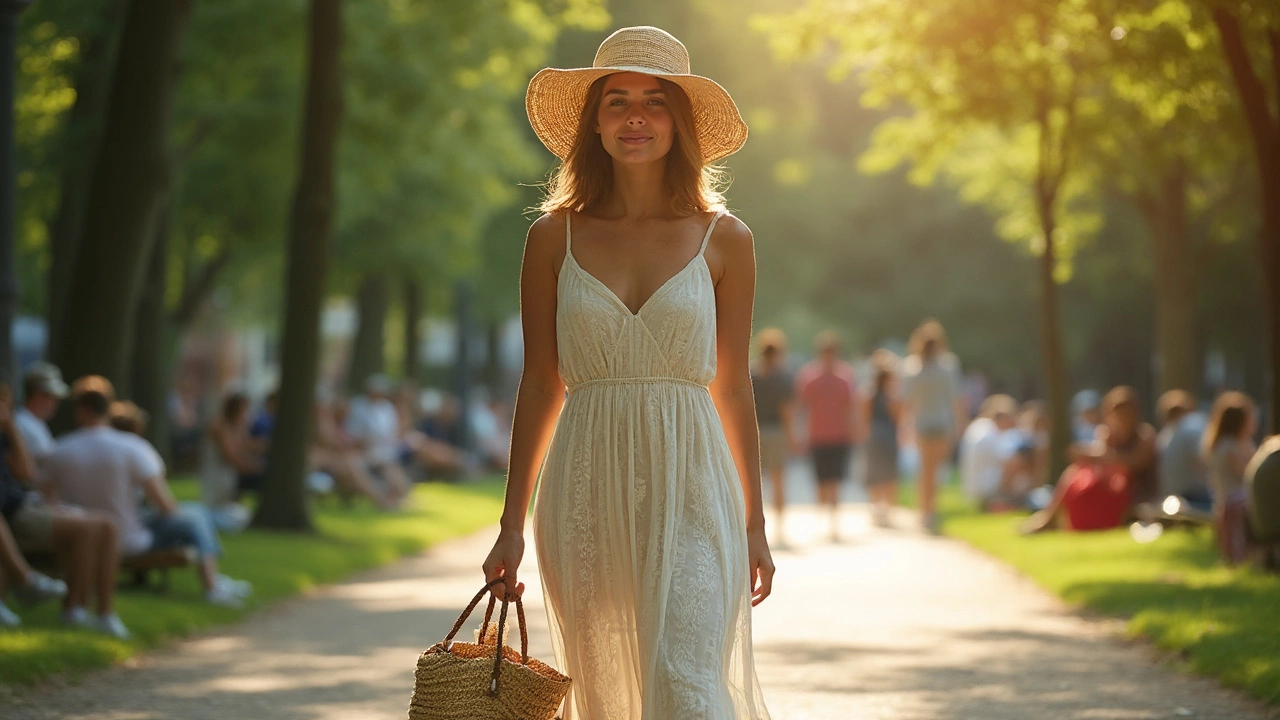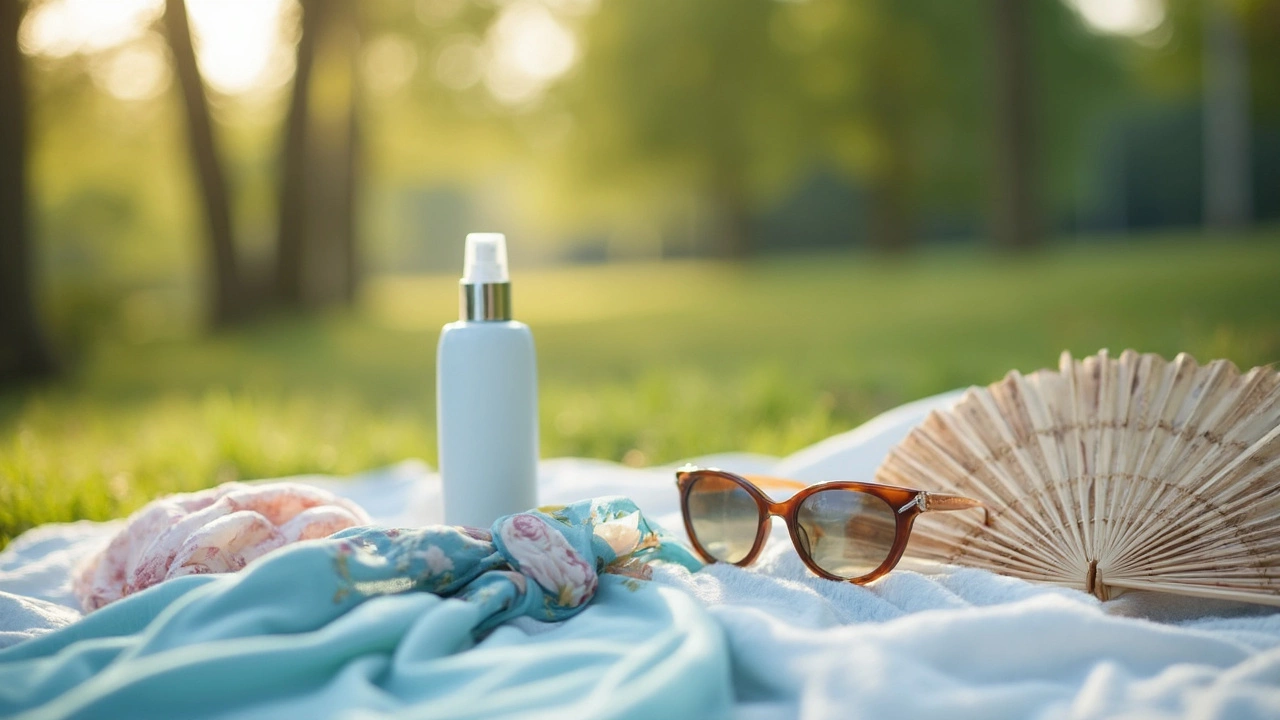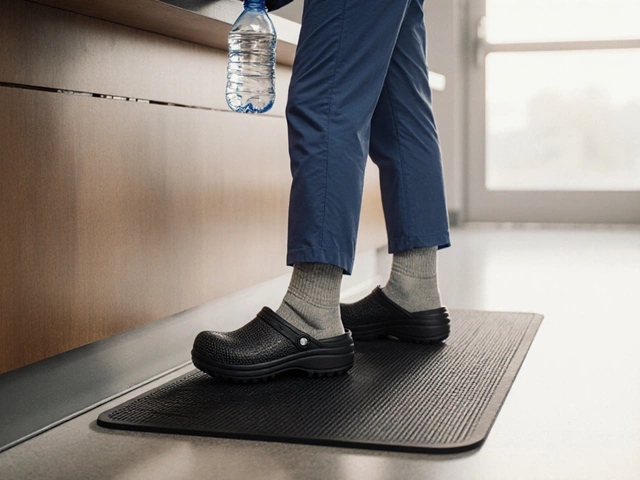What to Wear When It's 100 Degrees Outside: The Ultimate Guide to Surviving Summer in Style

- Cleo Fairchild
- 26 April 2025
- 0 Comments
Triple-digit temperatures hit differently—everything feels sticky, and stepping outside can feel like walking into an oven. What you wear makes a bigger impact than you might think, especially when you’re spending all day dodging sweat stains and sunburn. Not all summer dresses are created equal, either. Picking the right fabric and style can mean the difference between feeling cool and looking wilted before lunchtime.
Right off the bat, ditch anything heavy or synthetic. Cotton, linen, and rayon are your best friends because they let your skin breathe. Ever notice how polyester makes you feel even sweatier? That’s because it traps heat. Natural fibers, on the other hand, wick away moisture and dry fast, keeping you feeling fresher. Your prettiest dress isn’t so pretty if you’re stuck peeling it off your back by 3 p.m.
- Why Fabric Choice Matters Most
- Breezy Styles That Actually Work
- Colors, Patterns, and Keeping Cool
- Dress Hacks for Ultimate Comfort
- Must-Have Accessories for Hot Days
Why Fabric Choice Matters Most
When it’s 100 degrees outside, the type of fabric you pick for your summer dresses isn’t just about style—it’s the number one thing standing between you and feeling like a sticky mess by noon. Not every pretty dress will keep you cool, and some materials actually trap heat and sweat closer to your skin, making hot days feel even worse.
Cotton is the old standby for a reason. It’s lightweight, absorbs sweat, and lets air flow in and out. Linen is another summertime superstar; it breathes even more than cotton, dries lightning fast, and won’t cling when you start to sweat. On the other hand, synthetic fabrics—think polyester or nylon—are notorious for holding onto heat. They might look fancy, but you’ll pay for it in discomfort. If you see a tag that says “rayon,” give it a second look: it’s made from natural fibers, so it usually performs better than pure synthetics, especially for hot weather outfits.
Let’s get real with a side-by-side comparison:
| Fabric | Breathability | Moisture Wicking | Comfort in Heat |
|---|---|---|---|
| Cotton | High | Good | Great |
| Linen | Very High | Great | Excellent |
| Rayon | Medium-High | Good | Good |
| Polyester | Low | Poor | Bad |
If you love dresses with stretch, go for ones blended with just a tiny bit of elastane—too much, and you’ll lose that breezy feeling. Don’t forget that dark colors soak up more sun, so lighter shades in these breathable fabrics will keep you coolest. Some brands even label certain dresses as “cooling” or “moisture-wicking”—these usually pass the test for staying cool, but always check the tag before buying.
Breezy Styles That Actually Work
If you've ever worn a tight tank dress on a 100-degree day, you know that air flow matters way more than the label or price tag. When it comes to picking the right summer dresses for extreme heat, loose and flowy beats clingy every time. There’s nothing magic about it—more room means more air, less sweat sticking to your skin, and fewer heat rashes to worry about.
The classic sundress remains a real winner because it’s usually sleeveless, hangs loose from the waist, and lets you move without restriction. A-line, empire waist, and tiered smock dresses aren’t just trendy—they make sense. These styles keep the fabric away from problem spots like your lower back and thighs, where sweat piles up the fastest. Want to skip the constant readjusting? Look for wrap dresses or button-down shirt dresses, which you can loosen up if things get too steamy.
Cutouts, open backs, and deep V-necks aren’t just for looking cute on vacation. These design details help with ventilation where you need it most. But just make sure you pair them with good sunscreen or a lightweight cover if you’re out for more than a quick coffee.
Some folks swear by maxi dresses for hot weather outfits, and for good reason. Long, wide skirts don’t just protect you from the sun—they actually create their own little breeze every time you walk. Don’t fall for heavy maxi fabrics though. If there’s a lining, make sure it’s as thin as possible.
- Go for short sleeves or wide straps. Skinny spaghetti straps can dig in and make sweat marks more obvious.
- Pockets? Yes, always—just make sure they’re not lined with thick material or they can backfire.
- Avoid tight elastic bands around the waist or sleeves. They trap heat and leave those annoying red marks by the end of the day.
If you’re still not sure what works, real-life stats from retailer reports show that loose-fit shirt dresses and tiered midi dresses see a jump in sales every summer, especially when the weather forecast screams triple digits. People buy what actually helps them survive the heat, not just what looks good on Instagram.

Colors, Patterns, and Keeping Cool
Not all summer dresses are created equal when the sun’s blazing. Color matters a lot, and here’s why: light colors like white, pastels, beige, or pale blue reflect more sunlight than darker shades. Dark colors absorb more heat, turning your dress into a mini sauna. So if you’re serious about beating the heat, stick with light shades—your body will thank you.
Patterns play a role, too. You might think big, bold prints trap heat, but that’s not how it works. Patterns can actually hide sweat marks better than plain fabrics, making you less self-conscious when it’s sweltering out. Tiny florals or abstract prints are especially forgiving on really hot days. Plus, a good pattern makes it way easier to re-wear the same dress without anyone catching on.
Fun fact: Researchers at the University of Ghent found that white clothing keeps you cooler only if it’s loose and allows air flow. So, a baggy summer dress in white or a soft pastel is actually a practical choice—not just a style thing. This lines up with a quote from fashion and textile expert Dr. Lisa Bernstein:
“Light colors and breathability are the best combo for hot weather because they minimize how much heat gets trapped near your body.”
And don’t forget about sun protection. Did you know some fabrics come with built-in UV protection? If you’re out during peak hours, look for hot weather outfits that mention UPF (Ultraviolet Protection Factor) on the tag. These are tested to shield your skin from harmful rays, which is a pretty big deal if you hate sticky sunscreen or have sensitive skin.
| Color | Amount of Sunlight Reflected |
|---|---|
| White | Up to 90% |
| Pale Blue | About 75% |
| Light Pink | About 70% |
| Black | Less than 10% |
The bottom line? If you want to stay chill and avoid awkward sweat marks, grab a dress in a light color, roomy fit, and playful print. Picking the right summer fashion details lets you look cute and keep cool, no matter how high the temps climb.
Dress Hacks for Ultimate Comfort
When it’s 100 degrees outside, even the best summer dresses can use a little backup. Small tweaks make a huge difference in how comfy you stay. One big trick? Go for looser fits. Tight dresses trap heat and sweat, while roomy cuts keep the air moving and make you feel less sticky.
Pockets may sound like a bonus, but skip heavy ones, especially if you’re tempted to stuff them. That extra bulk clings to your skin and creates sweat zones. If you need to carry stuff, sling a tiny crossbody bag so your hands and dress stay free.
Another tip: Size up. Even if you normally wear a medium, buying your hot-weather dress a size bigger means better airflow and less clinging. Just check where it hits—too big and you risk looking sloppy, but a tiny bit of extra space can be a game-changer.
- Always check for built-in slips—thick inner layers are a no-go in triple digits. If your dress comes with one, cut it out and wear seamless, lightweight undergarments instead.
- Go for sleeveless or flutter sleeves. Cap sleeves are cute but can dig into sweaty armpits and make you even hotter.
- If you sweat a lot, try a moisture-absorbing liner like stick-on dress shields. They’re not glamorous, but they keep sweat stains off your favorite summer dresses, especially if you prefer light colors.
Here’s a quick look at which dress styles tend to run coolest based on fabric and fit:
| Dress Style | Main Fabric | Breathability |
|---|---|---|
| Shift Dress | Linen | Excellent |
| Sundress | Cotton | Very Good |
| Wrap Dress | Rayon | Good |
| Bodycon Mini | Polyester blend | Poor |
Avoid anything lined with dark fabrics since they absorb more heat. And if you’re wearing a dress with buttons, leave the top one or two undone for extra ventilation—no shame in needing to breathe.
Hydration is half the battle too. Stash a mini spray bottle in your bag and mist your neck and chest if you start feeling overheated. You’d be surprised how much that helps when you’re trapped outdoors during peak heat hours.

Must-Have Accessories for Hot Days
Don’t just grab a dress and hope for the best—accessories can make or break your summer dresses game when it’s 100 degrees out. Forget heavy jewelry or closed-toe shoes. Think light. Think practical. Here’s what actually helps when the sun is relentless.
- Wide-brimmed hats: These aren’t just for style. Dermatologists agree that a hat with at least a 3-inch brim can block up to 50% of UV rays from your face and neck, areas that burn fastest.
- UV-blocking sunglasses: Go for sunglasses with 100% UV protection. Eyes can get sunburned too, and squinting all day isn’t a look anyone loves.
- Lightweight scarves or wraps: A linen or cotton scarf around your shoulders gives you an extra layer of sun defense without smothering you. Plus, you can use it to sit on a hot bench or wipe off sweat in a pinch.
- Sunscreen—always: Not exactly an accessory you wear, but you’ll regret skipping it. Dermatologists recommend a broad-spectrum SPF 30 or higher, reapplied every two hours, especially when you’re rocking those hot weather outfits.
- Sandals: Stick with open-toed, breathable options. If you have to walk a lot, try sandals with arch support and straps that don’t rub. Remember, sweat + friction = blisters.
- Water bottle: Being hydrated is your secret weapon. Sweat can make you lose up to a liter of fluid an hour on extreme days. Carrying a stainless steel or insulated bottle keeps your water cold for hours.
- Chafing sticks or powders: Thanks to all the bare skin, thigh-chafe gets real in summer dresses. Prevent it before you leave home with an anti-chafing balm or even a simple powder.
Here’s something that surprises most people—when it comes to accessories, the right ones can lower your body temperature by several degrees. Check it out:
| Accessory | Effect |
|---|---|
| Wide-brimmed Hat | Reduces direct sun exposure, lowers face/neck temperature by up to 3°F. |
| UV Sunglasses | Prevents eye strain, helps avoid headaches from glare. |
| Insulated Water Bottle | Keeps water below air temp for 6+ hours. |
Wear your summer fashion smart. The right accessories aren’t just finishing touches—they’re your armor against the heat.


